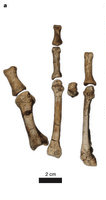
Transitional Tale Told by Toes
Transitional tale told by toes (and metatarsals) is full of sound and fury, signifying nothing.
News Source
East African rock layers contemporaneous with “Lucy” have yielded eight bones from the front part of “somebody’s” foot. But what kind of a somebody? More like a “Tarzan” or a “Cheetah”? Perhaps something in between?
American and Ethiopian scientists dug up the bones about 30 miles north of Lucy’s dig site. They believe the full foot had an opposable great toe for grasping tree branches and no arch. However, they interpret some subtleties in the shape of the bones as evidence that the owner “walked on two legs—at least some of the time” although “instead of pushing off from the big toe like [a] modern human, it took off from the outside of its feet.”
“Lucy” (an extinct ape known as Australopithecus afarensis) is conventionally dated at 2.9–3.6 million years old. Argon-argon dating1 of the Burtele tuff, volcanic rock above which the new foot bones were found, produced a date of 3.4 million years, making them more or less contemporary with Lucy. Argon-argon dating, however, like other radiometric dating methods, depends on an assumption that the original amount of the measured isotope (argon-40, in this case) was zero. Yet excess argon-40 has been found in volcanic rocks bearing both “recent” and “old” dates,2 making all argon-argon and potassium-argon “dates” and the fossil “dates” determined from them questionable. Furthermore, argon-argon dates must be calibrated by comparison with “known” dates. Yet the “known” dates are only “known” from radiometric results subject to the same unverifiable assumptions.3 Thus, though Lucy and the “Burtele foot” probably came from the same region of the geologic column, the 3+ million year dates accorded them are derived from unverifiable circular reasoning and foundational assumptions that have been proven unreliable.

Four toe bones and four metatarsal bones from the Burtele locality in Ethiopia. Photo from www.nature.com
Lucy is thought by many evolutionists to have had an arched foot and bipedal gait. The Burtele foot is considered “less advanced” because it is well-suited for climbing trees. Actually, the Burtele bones resemble the foot of an ape thought by evolutionists to be a million years older, Ardipithecus ramidus (“Ardi”). However, there are no other bones to allow the foot’s owner to be identified as Ardi’s cousin. The degree to which Ardi’s gait could be considered bipedal is highly debatable. The authors conclude the Burtele foot belonged to an ape able to effectively grab tree branches while being “at least facultatively bipedal, although it may have practiced bipedality in a novel fashion probably similar to Ar. ramidus [Ardi].”4 Of course, all that means this ape probably could, like the chimps we discussed last week, manage to walk upright when it really wanted to, though it was not anatomically designed to do so efficiently.
The Burtele foot also has much in common with gorilla feet. In fact, many comparisons made in the study and supplementary material published in Nature note the Burtele bones more closely resemble “humans and gorillas” than chimpanzees. For instance, the authors write, “Humans and gorillas have less curved phalanges [toes] than chimpanzees. The BRT-VP-2/73 phalanges [toes on the new fossil] are intermediate between the two groups.”5
When it comes right down to it, nobody gets famous for discovering an extinct ape’s foot. At least not without wedging that foot into the human evolutionary tree. And even though there is nothing inherently human about bipedality, the foot fossil from Burtele is headline fodder because its discoverers are convinced its owner shared not only Lucy’s world but also Lucy’s interest in experimenting with walking upright.
This is just another window into solving the problem of how we got from a primitive foot to the modern human foot.
Author Bruce Latimer says, “This is just another window into solving the problem of how we got from a primitive foot to the modern human foot.” Evolutionist William Harcourt-Smith of New York City’s American Museum of Natural History explains that bipedalism “was a complicated affair and not just a ‘one-off’ occurrence.” (Incidentally, Harcourt-Smith is skeptical about the significance of the foot bone claimed as proof Lucy’s foot was arched. The bone, being from the lateral part of the foot, does not contribute significantly to the most important arch in the human foot.)6
Thus, evolutionists who will not allow a divine foot in the door of humanity’s history are happy to accord significance to an extinct ape that can get around on two feet when it wants to with the implication that slight flattening of bones on the side of foot is somehow an evolutionary step in the right direction. Yet analysis of these eight little bones repeatedly suggests they belonged to an extinct creature like the ape Ardi or a gorilla. Only evolutionary imagination gives this fossil a toe-hold in humanity’s history.
This study’s significance arises from the evolutionary assertion that learning to walk upright was associated with becoming human. Biblically we know God created animals (including apes) and humans as separate creations on the 6th day of Creation week. Humans were made in the image of God with unique mental and spiritual attributes. And while our Common Designer gave us certain similar physical features, He also created apes and humans with many distinct differences. Nothing in the fossil record or genetics confirms humans evolved from ape-like ancestors. Humanity’s ancestors were Adam and Eve, created by God about 6,000 years ago fully able to walk on their own two feet.
NOTE: in a few weeks, an expanded "Lucy" exhibit inside the Creation Museum will open. It will show that this creature was not transitional between humans and an ape-like ancestor in the evolution story.
Further Reading
- Evaluating the Gait Analysis of Ardi
- Did Humans Really Evolve from Apelike Creatures?
- Scientists Admit Genetic Data Timing Uncertain
- Walking Up the Evolutionary Tree
- A Giant Leap for Lucy
- News to Note, November 12, 2011
- News to Note, February 12, 2011
- “Excess Argon”: The “Archilles’ Heel” of Potassium-Argon and Argon-Argon “Dating” of Volcanic Rocks
- Andesite Flows at Mt. Ngauruhoe, New Zealand, and the Implications for Potassium-Argon “Dating”
For More Information: Get Answers
Remember, if you see a news story that might merit some attention, let us know about it! (Note: if the story originates from the Associated Press, FOX News, MSNBC, the New York Times, or another major national media outlet, we will most likely have already heard about it.) And thanks to all of our readers who have submitted great news tips to us. If you didn’t catch all the latest News to Know, why not take a look to see what you’ve missed?
(Please note that links will take you directly to the source. Answers in Genesis is not responsible for content on the websites to which we refer. For more information, please see our Privacy Policy.)
Footnotes
- Yohannes Haile-Selassie et al., “A New Hominin Foot from Ethiopia Shows Multiple Pliocene Bipedal Adaptations,” Nature 483 (March 29, 2012): 565–569, doi:10.1038/nature10922.
- Andrew A. Snelling, “‘Excess Argon’: The ‘Archilles’ Heel’ of Potassium-Argon and Argon-Argon ‘Dating’ of Volcanic Rocks,” Acts & Facts 28 (1999), http://www.icr.org/article/excess-argon-archilles-heel-potassium-argon-dating; and Andrew A. Snelling, “Andesite Flows at Mt. Ngauruhoe, New Zealand, and the Implications for Potassium-Argon ‘Dating’,” Creation Science Fellowship, August 3–8, 1998, http://www.icr.org/research/index/researchp_as_r01.
- See “Radiometric Dating: Back to Basics,” “Radiometric Dating: Problems with the Assumptions,” and “Radiometric Dating: Making Sense of the Patterns.”
- Haile-Selassie, “A New Hominin Foot from Ethiopia Shows Multiple Pliocene Bipedal Adaptations.”
- Yohannes Haile-Selassie et al., “A New Hominin Foot from Ethiopia Shows Multiple Pliocene Bipedal Adaptations: Supplemental Information,” Nature 483 (March 29, 2012), http://www.nature.com/nature/journal/v483/n7391/extref/nature10922-s1.pdf.
- Ann Gibbons, “Lucy Had a Spring in Her Step,” Science February 10, 2011, http://www.sciencemag.org/news/2011/02/lucy-had-spring-her-step.
Recommended Resources

Answers in Genesis is an apologetics ministry, dedicated to helping Christians defend their faith and proclaim the good news of Jesus Christ.
- Customer Service 800.778.3390
- © 2024 Answers in Genesis







